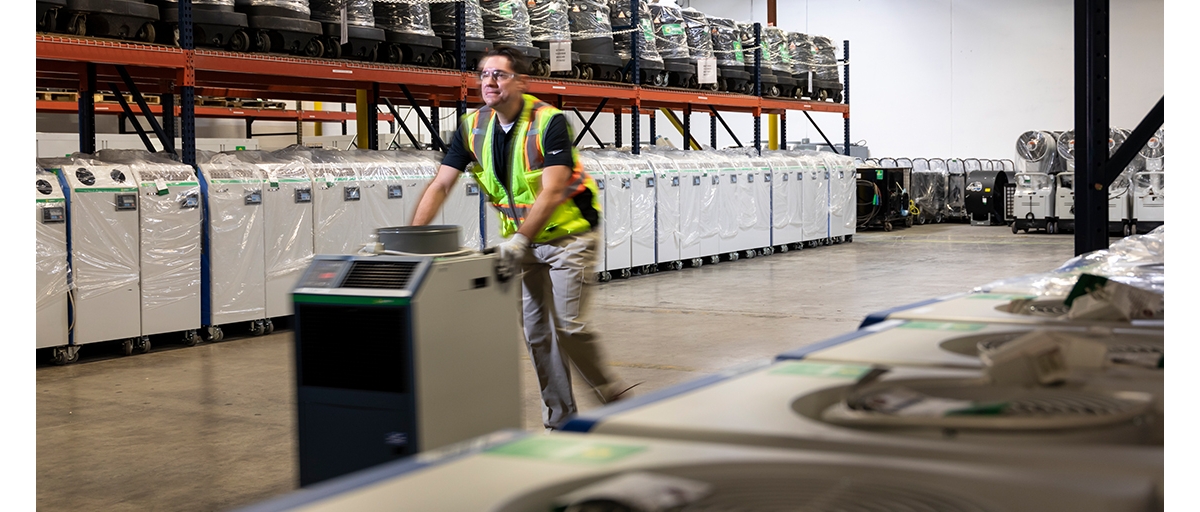Use the Sunbelt Rentals App
Find, rent, and return equipment, right at your fingertips

Portable Heat Pumps: An Easy and Efficient Heating Solution
As cold weather approaches, the time is right to review the technologies available for emergency, temporary, and supplemental heating applications. There are several efficient heating options on the market for commercial applications, but some are not as well understood as their portable air conditioning counterparts and are therefore sometimes underutilized.
Portable heat pumps are the latest technology to be utilized in commercial spaces. They look identical to the spot coolers that are so widely accepted for a variety of applications, but with the addition of a heating function that provides a safe and efficient solution. Portable heat pumps are unique in their ability to provide 3-in-1 heating, cooling, and dehumidification functions. Because of their versatility and the fact that so much of the country has seasonal needs for varying temperatures, portable heat pumps make for an ideal year-round solution.
Applications include spot heating and cooling of spaces such as office buildings and classrooms or retail stores. The portability of the units permits localized temperature control and the ability to roll out the units at the end of a rental period. Portable heat pumps can address “cold spots” as a personal preference for more cooling or heating than the general environment. Corner rooms, areas that receive less sunlight, or spaces that need extra heat due to lack of balance in the central system are common areas of use. Some additional applications include:
- Supplemental heating in chilly lobbies, restaurants, offices, manufacturing areas, special events, or hospitals.
- Emergency heating in moderate climates – portable heat pumps can be very effective during a cold snap in a usually temperate region.
- Nighttime and weekend thermostat setbacks – when a building’s central system is shut down or set back to a lower temperature for a night, weekend, or holiday closure, heat pumps can deliver spot heating targeted only to the areas that need it – at a much more efficient cost than the energy that would be required to heat the entire building.
- Temporary heating during renovation or repair of the primary HVAC system – In a high-rise tower or other large building, HVAC equipment repair or replacement is typically performed on a zoned basis, usually floor by floor. Portable heat pumps are ideal for contractors and maintenance teams to fill the gap and keep occupants comfortable during partial HVAC service or refurbishment. The portable units can be easily wheeled to different areas or floors as work progresses.
- Spot heating in retail stores – portable heat pumps are convenient in retail locations because they need no extra wiring; the units simply plug into the wall with no outside access needed through windows, making them safe and secure.
Understanding Heat Pump Technology
The most common type of portable heat pump today uses air-cooled technology. A reverse-cycle refrigeration system directs cooled and dehumidified air or warmed air to a conditioned space. In the cooling mode, a direct-expansion device allows the refrigerant to evaporate and cool a heat exchanger, which cools and dehumidifies an air stream flowing through the heat exchanger and then to the conditioned space. The heat absorbed from the air stream is rejected to the environment utilizing another air stream flowing through a condensing heat exchanger. In the heating mode, the functions of the heat exchangers and air streams described above are reversed. Heat is absorbed from the environment and rejected into the conditioned space.
Portable heat pumps typically range from 1 to 5 tons (or up to about 60,000 BTU/hr.) in capacity, are mounted on wheels, and are designed to fit through standard interior doors. Units at the lower end of this range can typically run on a standard 115-volt circuit, and larger capacity units will require higher voltages to operate. Some units have the capability to perform at ambient temperatures of 40°F, utilizing an expansion valve and an indoor/outdoor condenser which provides for maximum efficiency through a balanced condenser air pressure. Some portable heat pumps also have a built-in condenser plenum that draws warmer air from above the ceiling to increase heating output. Other units use a cap tube system that requires minimum ambient temperatures of 55°F to operate. Computerized controls that automatically switch from the cooling to heating function (or vice versa) are provided in some models, along with variable speed evaporator fans that automatically cycle down as the temperature in the space approaches set point.
Partner With an Expert To Calculate Heat Loads and Job Sizing
When you’re looking for a team to support your climate control needs, look for a supplier who not only carries a wide range of equipment types and sizes but also provides sizing and technical guidance. To ensure accurate calculations and job sizing, consult an expert partner to help engineer a custom solution for your application.
If you choose Sunbelt Rentals, you’ll get a turnkey solution with everything you need, along with white-glove service. Contact our experts today – we’d be happy to provide a free job sizing estimate.
